check transmission fluid MAZDA MODEL B3000 2002 Owners Manual (in English)
[x] Cancel search | Manufacturer: MAZDA, Model Year: 2002, Model line: MODEL B3000, Model: MAZDA MODEL B3000 2002Pages: 288, PDF Size: 2.94 MB
Page 168 of 288
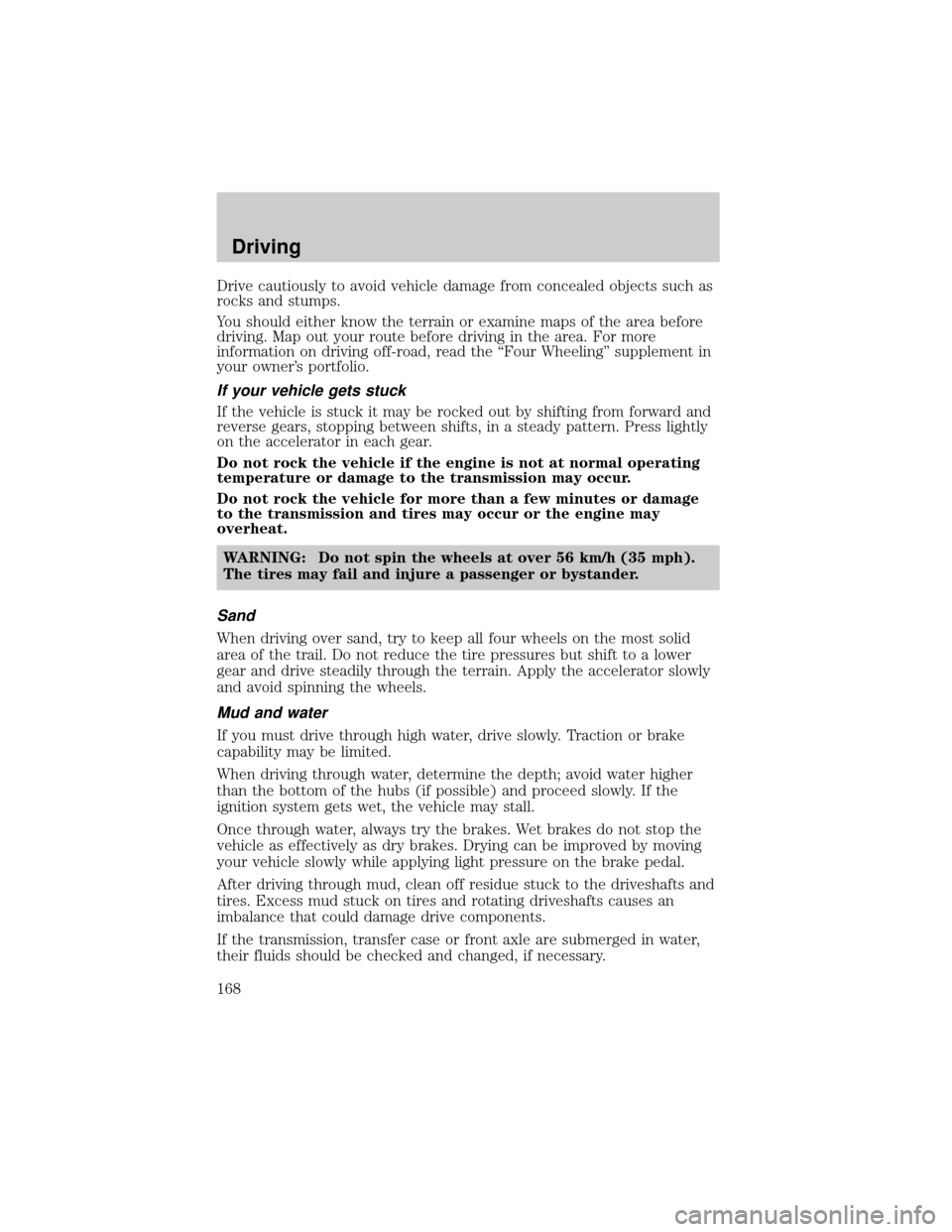
Drive cautiously to avoid vehicle damage from concealed objects such as
rocks and stumps.
You should either know the terrain or examine maps of the area before
driving. Map out your route before driving in the area. For more
information on driving off-road, read the ªFour Wheelingº supplement in
your owner's portfolio.
If your vehicle gets stuck
If the vehicle is stuck it may be rocked out by shifting from forward and
reverse gears, stopping between shifts, in a steady pattern. Press lightly
on the accelerator in each gear.
Do not rock the vehicle if the engine is not at normal operating
temperature or damage to the transmission may occur.
Do not rock the vehicle for more than a few minutes or damage
to the transmission and tires may occur or the engine may
overheat.
WARNING: Do not spin the wheels at over 56 km/h (35 mph).
The tires may fail and injure a passenger or bystander.
Sand
When driving over sand, try to keep all four wheels on the most solid
area of the trail. Do not reduce the tire pressures but shift to a lower
gear and drive steadily through the terrain. Apply the accelerator slowly
and avoid spinning the wheels.
Mud and water
If you must drive through high water, drive slowly. Traction or brake
capability may be limited.
When driving through water, determine the depth; avoid water higher
than the bottom of the hubs (if possible) and proceed slowly. If the
ignition system gets wet, the vehicle may stall.
Once through water, always try the brakes. Wet brakes do not stop the
vehicle as effectively as dry brakes. Drying can be improved by moving
your vehicle slowly while applying light pressure on the brake pedal.
After driving through mud, clean off residue stuck to the driveshafts and
tires. Excess mud stuck on tires and rotating driveshafts causes an
imbalance that could damage drive components.
If the transmission, transfer case or front axle are submerged in water,
their fluids should be checked and changed, if necessary.
Driving
168
Page 170 of 288

DRIVING THROUGH WATER
Do not drive quickly through standing water, especially if the depth is
unknown. Traction or brake capability may be limited and if the ignition
system gets wet, your engine may stall. Water may also enter your
engine's air intake and severely damage your engine.
If driving through deep or standing water is unavoidable, proceed very
slowly. Never drive through water that is higher than the bottom of the
hubs (for trucks) or the bottom of the wheel rims (for cars).
Once through the water, always try the brakes. Wet brakes do not stop
the vehicle as effectively as dry brakes. Drying can be improved by
moving your vehicle slowly while applying light pressure on the brake
pedal.
Driving through deep water where the transmission vent tube is
submerged may allow water into the transmission and cause
internal transmission damage. Have the fluid checked and, if
water is found, replace the fluid.
VEHICLE LOADING
Before loading a vehicle, familiarize yourself with the following terms:
²Base Curb Weight:Weight of the vehicle including any standard
equipment, fluids, lubricants, etc. It does not include occupants or
aftermarket equipment.
²Payload:Combined maximum allowable weight of cargo, occupants
and optional equipment. The payload equals the gross vehicle weight
rating minus base curb weight.
²GVW (Gross Vehicle Weight):Base curb weight plus payload
weight. The GVW is not a limit or a specification.
²GVWR (Gross Vehicle Weight Rating):Maximum permissible total
weight of the base vehicle, occupants, optional equipment and cargo.
The GVWR is specific to each vehicle and is listed on the Safety
Certification Label on the driver's door pillar.
²GAWR (Gross Axle Weight Rating):Carrying capacity for each axle
system. The GAWR is specific to each vehicle and is listed on the
Safety Certification Label on the driver's door pillar.
²GCW (Gross Combined Weight):The combined weight of the
towing vehicle (including occupants and cargo) and the loaded trailer.
²GCWR (Gross Combined Weight Rating):Maximum permissible
combined weight of towing vehicle (including occupants and cargo)
and the loaded trailer
Driving
170
Page 231 of 288
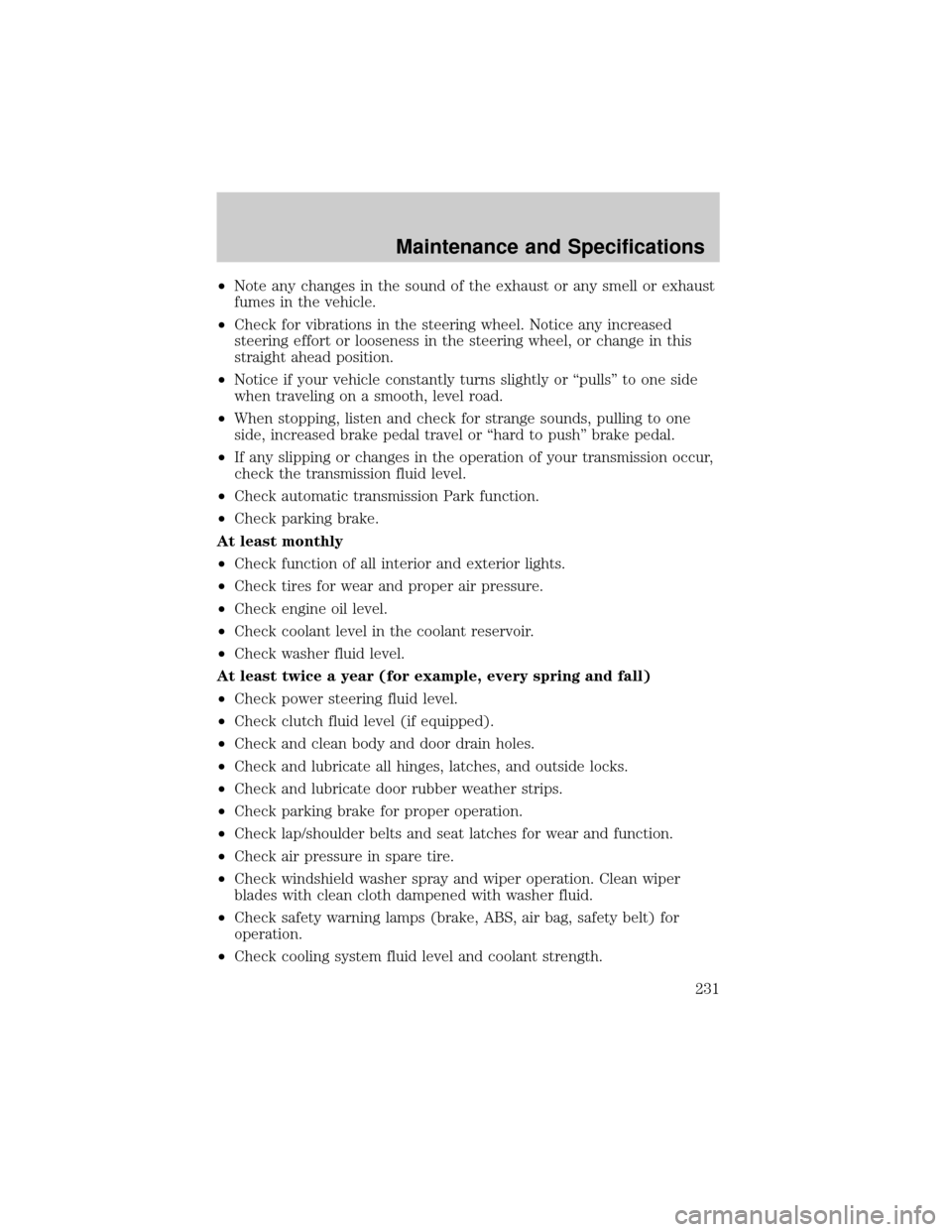
²Note any changes in the sound of the exhaust or any smell or exhaust
fumes in the vehicle.
²Check for vibrations in the steering wheel. Notice any increased
steering effort or looseness in the steering wheel, or change in this
straight ahead position.
²Notice if your vehicle constantly turns slightly or ªpullsº to one side
when traveling on a smooth, level road.
²When stopping, listen and check for strange sounds, pulling to one
side, increased brake pedal travel or ªhard to pushº brake pedal.
²If any slipping or changes in the operation of your transmission occur,
check the transmission fluid level.
²Check automatic transmission Park function.
²Check parking brake.
At least monthly
²Check function of all interior and exterior lights.
²Check tires for wear and proper air pressure.
²Check engine oil level.
²Check coolant level in the coolant reservoir.
²Check washer fluid level.
At least twice a year (for example, every spring and fall)
²Check power steering fluid level.
²Check clutch fluid level (if equipped).
²Check and clean body and door drain holes.
²Check and lubricate all hinges, latches, and outside locks.
²Check and lubricate door rubber weather strips.
²Check parking brake for proper operation.
²Check lap/shoulder belts and seat latches for wear and function.
²Check air pressure in spare tire.
²Check windshield washer spray and wiper operation. Clean wiper
blades with clean cloth dampened with washer fluid.
²Check safety warning lamps (brake, ABS, air bag, safety belt) for
operation.
²Check cooling system fluid level and coolant strength.
Maintenance and Specifications
231
Page 232 of 288
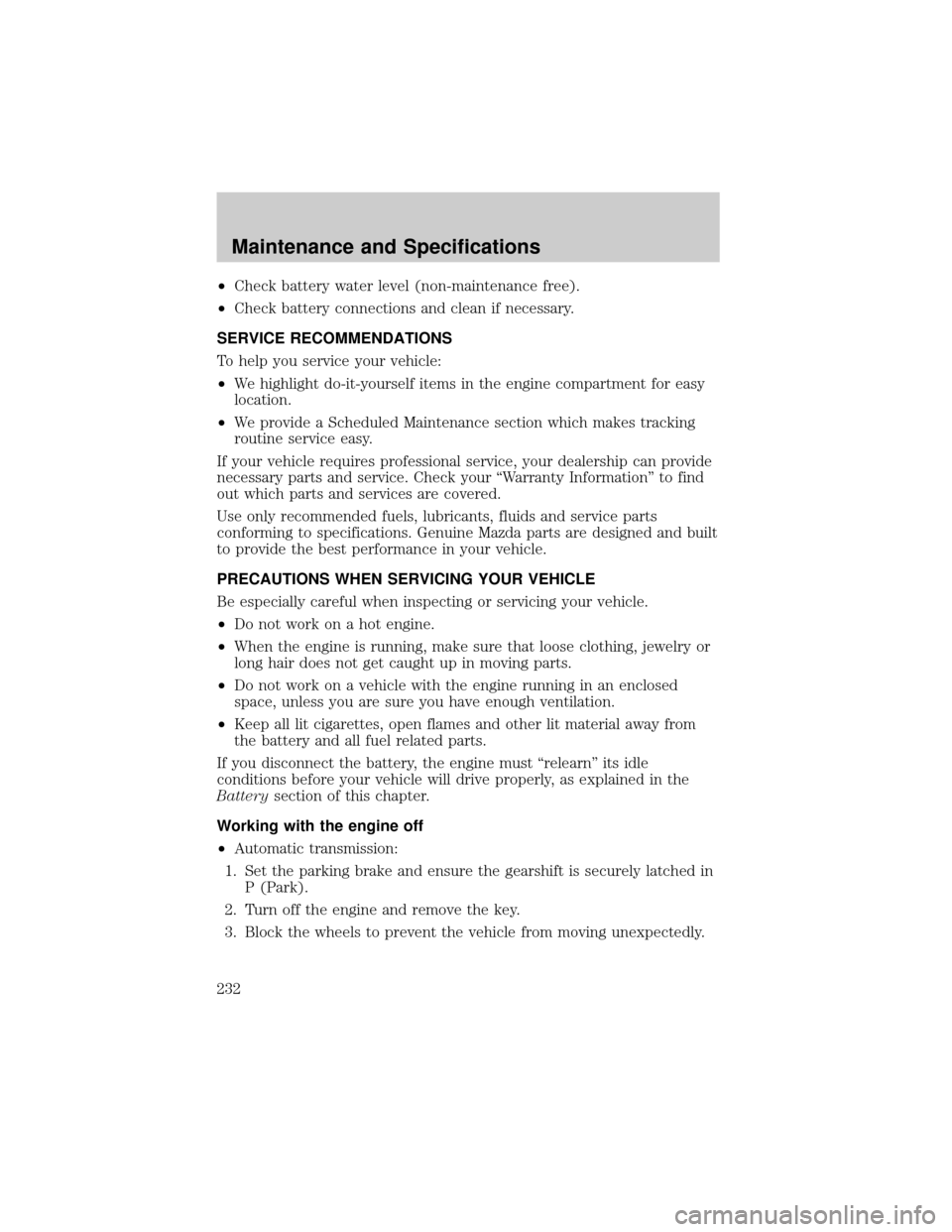
²Check battery water level (non-maintenance free).
²Check battery connections and clean if necessary.
SERVICE RECOMMENDATIONS
To help you service your vehicle:
²We highlight do-it-yourself items in the engine compartment for easy
location.
²We provide a Scheduled Maintenance section which makes tracking
routine service easy.
If your vehicle requires professional service, your dealership can provide
necessary parts and service. Check your ªWarranty Informationº to find
out which parts and services are covered.
Use only recommended fuels, lubricants, fluids and service parts
conforming to specifications. Genuine Mazda parts are designed and built
to provide the best performance in your vehicle.
PRECAUTIONS WHEN SERVICING YOUR VEHICLE
Be especially careful when inspecting or servicing your vehicle.
²Do not work on a hot engine.
²When the engine is running, make sure that loose clothing, jewelry or
long hair does not get caught up in moving parts.
²Do not work on a vehicle with the engine running in an enclosed
space, unless you are sure you have enough ventilation.
²Keep all lit cigarettes, open flames and other lit material away from
the battery and all fuel related parts.
If you disconnect the battery, the engine must ªrelearnº its idle
conditions before your vehicle will drive properly, as explained in the
Batterysection of this chapter.
Working with the engine off
²Automatic transmission:
1. Set the parking brake and ensure the gearshift is securely latched in
P (Park).
2. Turn off the engine and remove the key.
3. Block the wheels to prevent the vehicle from moving unexpectedly.
Maintenance and Specifications
232
Page 263 of 288

CLUTCH FLUID (IF EQUIPPED)
Check the fluid level. Refer to the service maintenance section for the
service interval schedules.
During normal operation, the fluid level in the clutch reservoir should
remain constant. If the fluid level drops, refill the fluid level to the step
in the reservoir.
Use only a DOT 3 brake fluid designed to meet Mazda specification.
Refer toLubricant Specificationsin this chapter.
WARNING: Brake fluid is toxic. If brake fluid contacts the
eyes, flush eyes with running water for 15 minutes. Seek
medical attention if irritation persists. If taken internally, drink
water and induce vomiting. Seek medical attention immediately.
1. Clean the reservoir cap before
removal to prevent dirt and
water from entering the
reservoir.
2. Remove cap and rubber
diaphragm from reservoir.
3. Add fluid until the level reaches
the step in the reservoir.
4. Reinstall rubber diaphragm and
cap onto reservoir.
TRANSMISSION FLUID
Checking automatic transmission fluid (if equipped)
Refer to your service maintenance section for scheduled intervals for
fluid checks and changes. Your transmission does not consume fluid.
However, the fluid level should be checked if the transmission is not
working properly, i.e., if the transmission slips or shifts slowly or if you
notice some sign of fluid leakage.
Automatic transmission fluid expands when warmed. To obtain an
accurate fluid check, drive the vehicle until it is at normal operating
Maintenance and Specifications
263
Page 264 of 288
![MAZDA MODEL B3000 2002 Owners Manual (in English) temperature (approximately 30 km [20 miles]). If your vehicle has been
operated for an extended period at high speeds, in city traffic during hot
weather or pulling a trailer, the vehicle should be tu MAZDA MODEL B3000 2002 Owners Manual (in English) temperature (approximately 30 km [20 miles]). If your vehicle has been
operated for an extended period at high speeds, in city traffic during hot
weather or pulling a trailer, the vehicle should be tu](/img/28/13743/w960_13743-263.png)
temperature (approximately 30 km [20 miles]). If your vehicle has been
operated for an extended period at high speeds, in city traffic during hot
weather or pulling a trailer, the vehicle should be turned off for about 30
minutes to allow fluid to cool before checking.
1. Drive the vehicle 30 km (20 miles) or until it reaches normal
operating temperature.
2. Park the vehicle on a level surface and engage the parking brake.
3. With the parking brake engaged and your foot on the brake pedal,
start the engine and move the gearshift lever through all of the gear
ranges. Allow sufficient time for each gear to engage.
4. Latch the gearshift lever in P (Park) and leave the engine running.
5. Remove the dipstick, wiping it clean with a clean, dry lint free rag. If
necessary, refer toIdentifying components in the engine
compartmentin this chapter for the location of the dipstick.
6. Install the dipstick making sure it is fully seated in the filler tube.
7. Remove the dipstick and inspect the fluid level. The fluid should be
in the designated area for normal operating temperature or ambient
temperature.
Low fluid level
Do not drive the vehicle if the fluid
level is at the bottom of the dipstick
and the ambient temperature is
above 10ÉC (50ÉF).
Correct fluid level
The transmission fluid should be checked at normal operating
temperature 66ÉC-77ÉC (150ÉF-170ÉF) on a level surface. The normal
operating temperature can be reached after approximately 30 km (20
miles) of driving.
You can check the fluid without driving if the ambient temperature is
above 10ÉC (50ÉF). However, if fluid is added at this time, an overfill
condition could result when the vehicle reaches normal operating
temperature.
The transmission fluid should be in
this range if at normal operating
temperature (66ÉC-77ÉC
[150ÉF-170ÉF]).
Maintenance and Specifications
264
Page 266 of 288
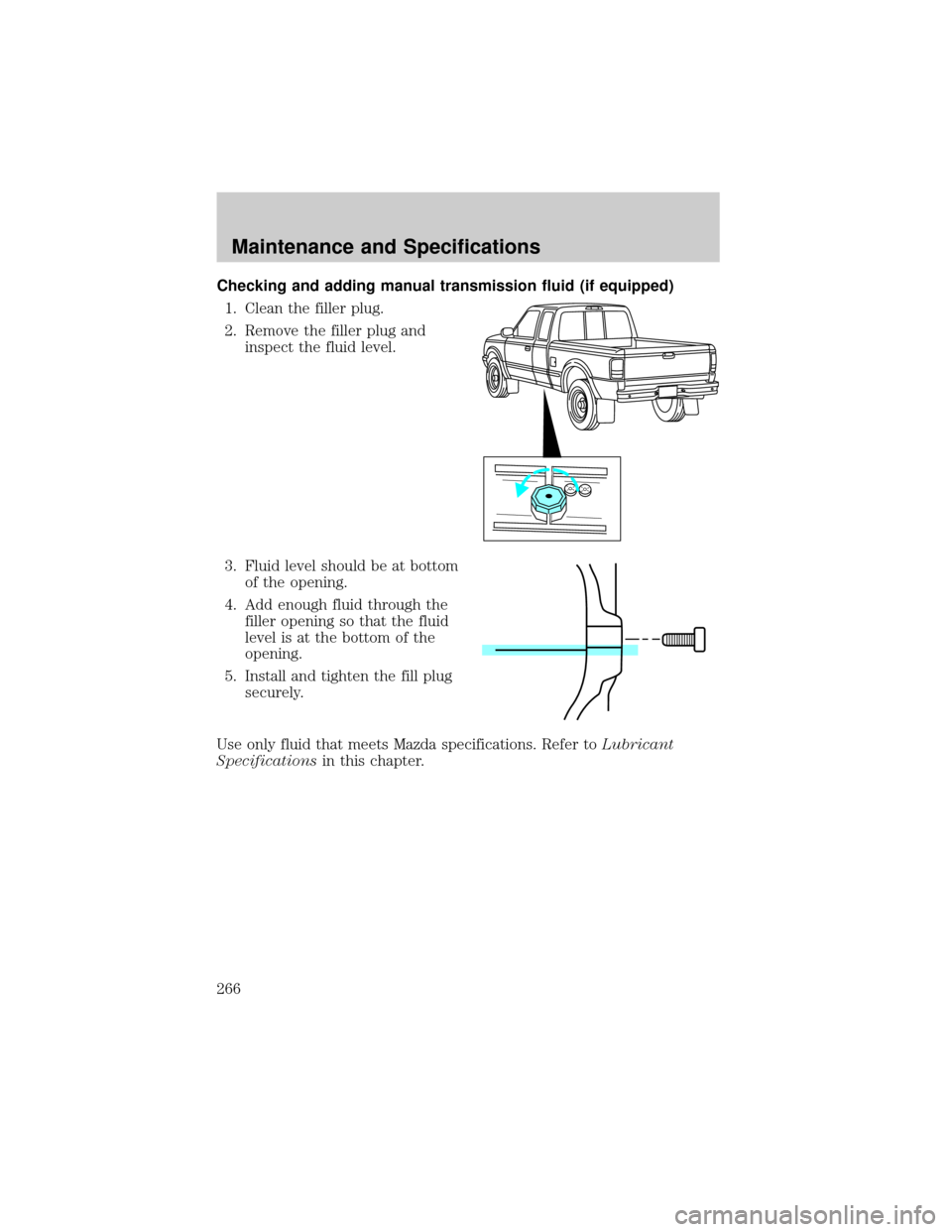
Checking and adding manual transmission fluid (if equipped)
1. Clean the filler plug.
2. Remove the filler plug and
inspect the fluid level.
3. Fluid level should be at bottom
of the opening.
4. Add enough fluid through the
filler opening so that the fluid
level is at the bottom of the
opening.
5. Install and tighten the fill plug
securely.
Use only fluid that meets Mazda specifications. Refer toLubricant
Specificationsin this chapter.
Maintenance and Specifications
266
Page 275 of 288
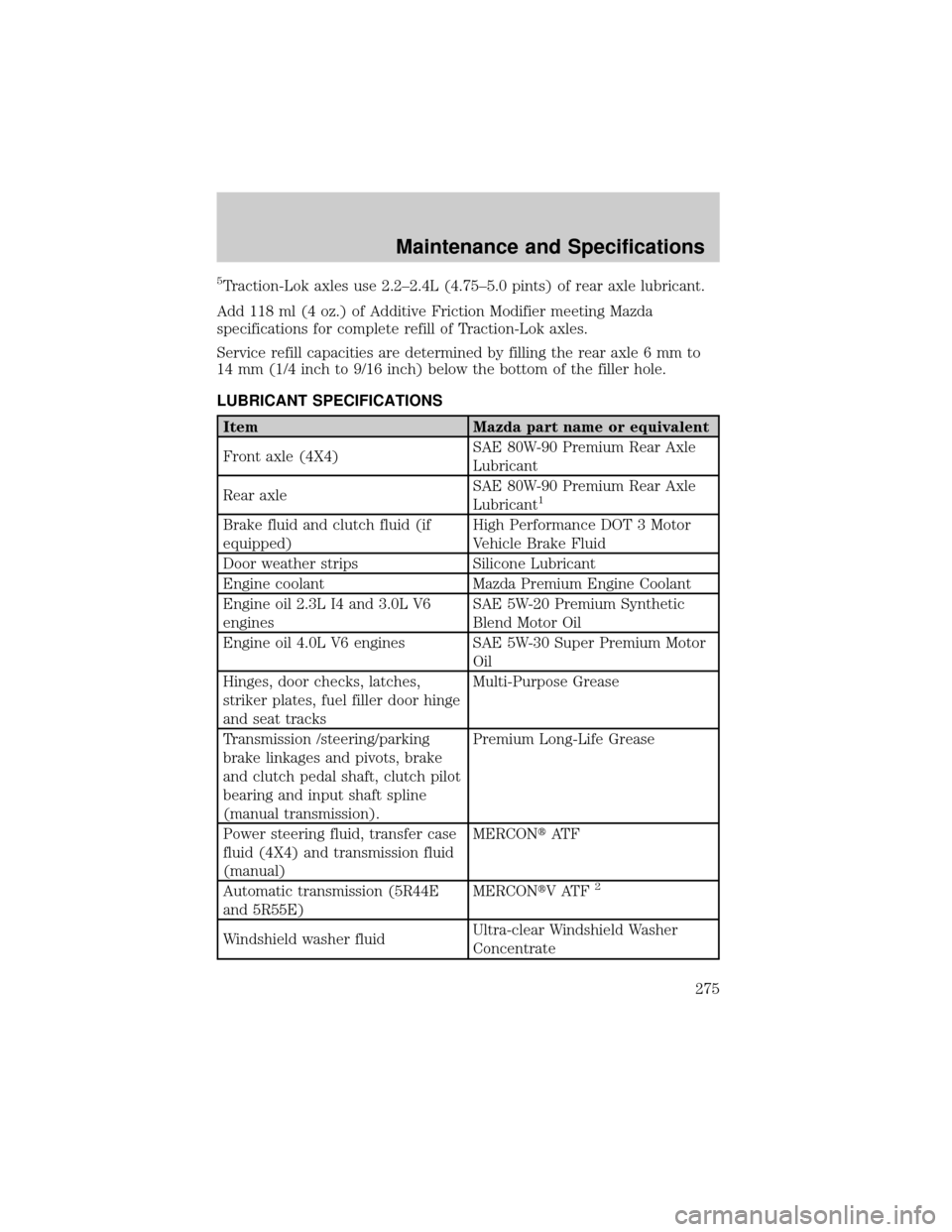
5Traction-Lok axles use 2.2±2.4L (4.75±5.0 pints) of rear axle lubricant.
Add 118 ml (4 oz.) of Additive Friction Modifier meeting Mazda
specifications for complete refill of Traction-Lok axles.
Service refill capacities are determined by filling the rear axle 6 mm to
14 mm (1/4 inch to 9/16 inch) below the bottom of the filler hole.
LUBRICANT SPECIFICATIONS
Item Mazda part name or equivalent
Front axle (4X4)SAE 80W-90 Premium Rear Axle
Lubricant
Rear axleSAE 80W-90 Premium Rear Axle
Lubricant
1
Brake fluid and clutch fluid (if
equipped)High Performance DOT 3 Motor
Vehicle Brake Fluid
Door weather strips Silicone Lubricant
Engine coolant Mazda Premium Engine Coolant
Engine oil 2.3L I4 and 3.0L V6
enginesSAE 5W-20 Premium Synthetic
Blend Motor Oil
Engine oil 4.0L V6 engines SAE 5W-30 Super Premium Motor
Oil
Hinges, door checks, latches,
striker plates, fuel filler door hinge
and seat tracksMulti-Purpose Grease
Transmission /steering/parking
brake linkages and pivots, brake
and clutch pedal shaft, clutch pilot
bearing and input shaft spline
(manual transmission).Premium Long-Life Grease
Power steering fluid, transfer case
fluid (4X4) and transmission fluid
(manual)MERCONtAT F
Automatic transmission (5R44E
and 5R55E)MERCONtVATF
2
Windshield washer fluidUltra-clear Windshield Washer
Concentrate
Maintenance and Specifications
275
Page 280 of 288

A
ABS (see Brakes) .....................154
Air bag supplemental restraint
system ................................119±120
and child safety seats ............122
description ..............................120
disposal ....................................126
driver air bag ..........................124
indicator light .............14±15, 125
operation .................................124
passenger air bag ...................124
passenger deactivation
switch ......................................126
Air conditioning
manual heating and air
conditioning system .................69
Ambulance packages ....................7
Antifreeze (see Engine
coolant) .....................................245
Anti-lock brake system
(see Brakes) ......................154±155
Anti-theft system
warning light .............................16
Audio system
(see Radio) ......................21, 45, 53
Automatic transmission ............158
driving an automatic
overdrive .................................159
fluid, adding ............................263
fluid, checking ........................263
fluid, refill capacities ..............272
fluid, specification ..................276
Auxiliary power point .................84
Axle
lubricant specifications ..275±276
refill capacities ........................272
traction lok ..............................157
B
Battery .......................................243acid, treating emergencies .....243
charging system warning
light ............................................15
jumping a disabled battery ....201
maintenance-free ....................243
servicing ..................................243
voltage gauge ............................19
Bed extender ..............................95
BeltMinder .................................115
Brakes ........................................153
anti-lock ...........................154±155
anti-lock brake system (ABS)
warning light .....................14, 155
brake warning light ..................13
fluid, checking and adding ....262
fluid, refill capacities ..............272
fluid, specifications .........275±276
lubricant specifications ..275±276
parking ....................................155
shift interlock ..........................158
Break-in period .............................5
Bulbs ............................................75
C
Capacities for refilling fluids ....272
Cargo area shade ........................95
Cargo net .....................................95
CD-6 disc .....................................53
CD-single .....................................25
CD-single premium .....................45
Cell phone warning ...................279
Certification Label ....................278
Changing a tire .........................194
Child safety restraints ..............132
child safety belts ....................132
Child safety seats ......................135
Index
280
Page 281 of 288

attaching with tether straps ..140
in front seat ............................136
in rear seat ......................136, 139
LATCH .....................................145
tether anchorage hardware ...140
Cleaning your vehicle
engine compartment ..............219
exterior ....................................223
instrument cluster lens ..........222
instrument panel ....................222
interior .....................................222
mirrors .....................................221
plastic parts ............................221
washing ....................................218
waxing .....................................218
wheels ......................................219
wiper blades ............................221
Climate control (see Air
conditioning or Heating) ......68±69
Clock ....................24, 31, 44, 52, 64
Clutch
fluid ..........................................263
operation while driving ..........162
recommended shift speeds ....164
Compass, electronic ..............86±87
calibration .................................88
set zone adjustment .................87
Console ........................................94
Coolant
checking and adding ..............245
refill capacities ................249, 272
specifications ..................275±276
Cruise control (see Speed
control) ........................................89
Customer
Assistance ..........181, 207±208, 211
Ford accessories for your
vehicle .....................................223
Getting roadside assistance ...181D
Daytime running lamps
(see Lamps) ................................73
Dipstick
automatic transmission
fluid ..........................................263
engine oil .................................238
Doors
door ajar warning .....................16
lubricant specifications ..........275
Driveline universal joint and
slip yoke ....................................267
Driving under special
conditions ..........................168±169
mud ..........................................168
sand .........................................168
snow and ice ...........................169
through water .................168, 170
E
Emergencies, roadside
jump-starting ..........................201
Emission control system ..........259
Engine ........................................276
check engine/service engine
soon light ..................................12
cleaning ...................................219
coolant .....................................245
idle speed control ...................243
lubrication
specifications ..................275±276
refill capacities ........................272
service points ..................234±236
starting after a collision .........182
Engine block heater .................152
Engine oil ..................................238
checking and adding ..............238
dipstick ....................................238
Index
281